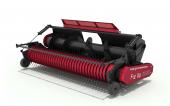Mowing grasses for hay, silage or haylage is a time–consuming and complex process, on which the quality of the future feed depends. In this matter, it is necessary to strictly comply with the requirements for the vegetation phase of plants, weather conditions, cleaning time and, of course, for the selection of equipment. In addition to the timing of mowing, the nutritional value of green feed can also be influenced by such technical features of mowers as: the speed of operation, the presence of a function of plowing or flattening, copying the relief and much more.
The second stage of the processing of green feeds is the roll formation with preliminary tilling, wrapping or fluffing of the mown mass. All these manipulations lead to a decrease in the density of grass laying and a reduction in drying time by 15-20%. With the help of rakes of various modifications, it is possible to achieve uniform drying of green feeds and a neatly formed roll.
Pressing, in contrast to the preparation of loose hay, has a number of exceptional advantages. Firstly, in terms of reducing labor costs (by 40-45%) and technical resources. Secondly, leaves and inflorescences are better preserved in pressed hay. Thirdly, pressed feed is stored longer, transported more conveniently and distributed to animals. A tangible reduction in energy resources and the cost of feed production can be achieved by maximizing the technical capabilities and productivity of various types of balers.
When harvesting feed in especially large sizes with a tractor and a set of trailed equipment, it is no longer possible to do. The capacity of up to 50-100 tons per hour can only be provided by a self-propelled forage harvester with appropriate adapters. Reliable relief copying and overload protection systems in grass harvesters and pickers allow you to provide the specified performance indicators and effectively remove grass for green fodder.














